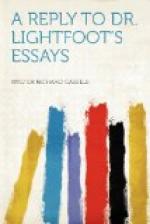“In this case, therefore, again, Volkmar alone offers any arguments in support of the statement in the text; and the final result of the references is, that the alleged ‘demonstration’ is, at the most, what Scholten calls ‘a not groundless conjecture.’” [98:1]
It is scarcely possible to imagine a more complete misrepresentation of the fact than the assertion that “Volkmar alone offers any arguments in support of the statement in the text,” and it is incomprehensible upon any ordinary theory. My mere sketch cannot possibly convey an adequate idea of the elaborate arguments of Volkmar, Baur, and Hilgenfeld, but I hope to state their main features, a few pages on. With regard to Dr. Westcott’s remark on the “alleged ‘demonstration,’” it must be evident that when a writer states anything to be “demonstrated” he expresses his own belief. It is impossible to secure absolute unanimity of opinion, and the only question in such a case is whether I refer to writers, in connection with the circumstances which I affirm to be demonstrated, who advance arguments and evidence bearing upon it. A critic is quite at liberty to say that the arguments are insufficient, but he is not at liberty to deny that there are any arguments at all when the elaborate reasoning of men like Volkmar, Baur, and Hilgenfeld is referred to. Therefore, when he goes on to say:
“It seems quite needless to multiply comments on these results. Anyone who will candidly consider this analysis will, I believe, agree with me in thinking that such a style of annotation, which runs through the whole work, is justly characterised as frivolous and misleading”—[99:1]
Dr. Westcott must excuse my retorting that, not my annotation, but his own criticism of it, endorsed by Professor Lightfoot, is “frivolous and misleading,” and I venture to hope that this analysis, tedious as it has been, may once for all establish the propriety and substantial accuracy of my references.
As Dr. Westcott does not advance any further arguments of his own in regard to the Ignatian controversy, I may now return to Dr. Lightfoot, and complete my reply to his objections; but I must do so with extreme brevity, as I have already devoted too much space to this subject, and must now come to a close. To the argument that it is impossible to suppose that soldiers such as the “ten leopards” described in the Epistles would allow a prisoner, condemned to wild beasts for professing Christianity, deliberately to write long epistles at every stage of his journey, promulgating the very doctrines for which he was condemned, as well as to hold the freest intercourse with deputations from the various Churches, Dr. Lightfoot advances arguments, derived from Zahn, regarding the Roman procedure in cases that are said to be “known.” These cases, however, are neither analogous, nor have they the force which is assumed. That Christians imprisoned for their religious belief should receive




